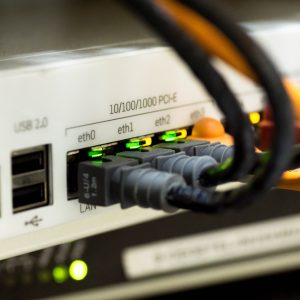CompTIA Security+

CompTIA Security+
CompTIA Security+
The CompTIA Security+ certification exam will verify the successful candidate has the knowledge and skills required to assess the security posture of an enterprise environment and recommend and implement appropriate security solutions.
£3,100.00
Out of stock
Is this course right for me?
The CompTIA Security+ certification exam will verify the successful candidate has the knowledge and skills required to assess the security posture of an enterprise environment and recommend and implement appropriate security solutions; monitor and secure hybrid environments, including cloud, mobile, and IoT; operate with an awareness of applicable laws and policies, including principles of governance, risk, and compliance; identify, analyse, and respond to security events and incidents.
“There is additional content and labs in this new version of Security+. A delegate should be prepared to study material and complete labs not covered during the course attend, in their own time.
After completing this course you should be able to:
- Compare security roles and security controls
- Explain threat actors and threat intelligence
- Perform security assessments and identify social engineering attacks and malware types
- Summarize basic cryptographic concepts and implement public key infrastructure
- Implement authentication controls
- Implement identity and account management controls
- Implement secure network designs, network security appliances, and secure network protocols
- Implement host, embedded/Internet of Things, and mobile security solutions
- Implement secure cloud solutions
- Explain data privacy and protection concepts
- Perform incident response and digital forensics
- Summarize risk management concepts and implement cybersecurity resilience
- Explain physical security
This course is delivered virtually.
Any questions?
If you have any questions about this course, please do not hesitate to contact our Central team, during working hours, on 01437 753 320 or anytime via email central@pembrokeshire.ac.uk
- No formal entry requirements
Comparing Security Roles and Security Controls
- Compare and Contrast Information Security Roles
- Compare and Contrast Security Control and Framework Types
Explaining Threat Actors and Threat Intelligence
- Explain Threat Actor Types and Attack Vectors
- Explain Threat Intelligence Sources
Performing Security Assessments
- Assess Organizational Security with Network
- Reconnaissance Tools
- Explain Security Concerns with General Vulnerability Types
- Summarize Vulnerability Scanning Techniques
- Explain Penetration Testing Concepts
Identifying Social Engineering and Malware
- Compare and Contrast Social Engineering Techniques
- Analyze Indicators of Malware-Based Attacks
Summarizing Basic Cryptographic Concepts
- Compare and Contrast Cryptographic Ciphers
- Summarize Cryptographic Modes of Operation
- Summarize Cryptographic Use Cases and Weaknesses
- Summarize Other Cryptographic Technologies
Implementing Public Key Infrastructure
- Implement Certificates and Certificate Authorities
- Implement PKI Management
Implementing Authentication Controls
- Summarize Authentication Design Concepts
- Implement Knowledge-Based Authentication
- Implement Authentication Technologies
- Summarize Biometrics Authentication Concepts
Implementing Identity and Account Management Controls
- Implement Identity and Account Types
- Implement Account Policies
- Implement Authorization Solutions
- Explain the Importance of Personnel Policies
Implementing Secure Network Designs
- Implement Secure Network Designs
- Implement Secure Switching and Routing
- Implement Secure Wireless Infrastructure
- Implement Load Balancers
Implementing Network Security Appliances
- Implement Firewalls and Proxy Servers
- Implement Network Security Monitoring
- Summarize the Use of SIEM
Implementing Secure Network Protocols
- Implement Secure Network Operations Protocols
- Implement Secure Application Protocols
- Implement Secure Remote Access Protocols
Implementing Host Security Solutions
- Implement Secure Firmware
- Implement Endpoint Security
- Explain Embedded System Security Implications
Implementing Secure Mobile Solutions
- Implement Mobile Device Management
- Implement Secure Mobile Device Connections
Summarizing Secure Application Concepts
- Analyze Indicators of Application Attacks
- Analyze Indicators of Web Application Attacks
- Summarize Secure Coding Practices
- Implement Secure Script Environments
- Summarize Deployment and Automation Concepts
Implementing Secure Cloud Solutions
- Summarize Secure Cloud and Virtualization Services
- Apply Cloud Security Solutions
- Summarize Infrastructure as Code Concepts
Explaining Data Privacy and Protection Concepts
- Explain Privacy and Data Sensitivity Concepts
- Explain Privacy and Data Protection Controls
Performing Incident Response
- Summarize Incident Response Procedures
- Utilize Appropriate Data Sources for Incident Response
- Apply Mitigation Controls
Explaining Digital Forensics
- Explain Key Aspects of Digital Forensics Documentation
- Explain Key Aspects of Digital Forensics Evidence Acquisition
Summarizing Risk Management Concepts
- Explain Risk Management Processes and Concepts
- Explain Business Impact Analysis Concepts
Implementing Cybersecurity Resilience
- Implement Redundancy Strategies
- Implement Backup Strategies
- Implement Cybersecurity Resiliency Strategies
Explaining Physical Security
- Explain the Importance of Physical Site Security Controls
- Explain the Importance of Physical Host Security Controls
Labs
- 01: Assisted Lab: Exploring the Lab Environment
- 02: Assisted Lab: Scanning and Identifying Network Nodes
- 03: Assisted Lab: Intercepting and Interpreting Network Traffic with Packet Sniffing Tools
- 04: Assisted Lab: Analyzing the Results of a Credentialed Vulnerability Scan
- 05: Assisted Lab: Installing, Using, and Blocking a Malware-based Backdoor
- 06: Applied Lab: Performing Network Reconnaissance and Vulnerability Scanning
- 07: Assisted Lab: Managing the Life Cycle of a Certificate
- 08: Assisted Lab: Managing Certificates with OpenSSL
- 09: Assisted Lab: Auditing Passwords with a Password Cracking Utility
- 10: Assisted Lab: Managing Centralized Authentication
- 11: Assisted Lab: Managing Access Controls in Windows Server
- 12: Assisted Lab: Configuring a System for Auditing Policies
- 13: Assisted Lab: Managing Access Controls in Linux
- 14: Applied Lab: Configuring Identity and Access Management Controls
- 15: Assisted Lab: Implementing a Secure Network Design
- 16: Assisted Lab: Configuring a Firewall
- 17: Assisted Lab: Configuring an Intrusion Detection System
- 18: Assisted Lab: Implementing Secure Network Addressing Services
- 19: Assisted Lab: Implementing a Virtual Private Network
- 20: Assisted Lab: Implementing a Secure SSH Server
- 21: Assisted Lab: Implementing Endpoint Protection
- 22: Applied Lab: Securing the Network Infrastructure
- 23: Assisted Lab: Identifying Application Attack Indicators
- 24: Assisted Lab: Identifying a Browser Attack
- 25: Assisted Lab: Implementing PowerShell Security
- 26: Assisted Lab: Identifying Malicious Code
Learners have the option to complete course assessment/assignments or elements of the course through the medium of Welsh or bilingually. Visit our Welsh Language in the College page to find out what else is available to you.
- Written examination
- It would be beneficial, but not essential, to bring your own device/laptop to support your studies
Any costs above are approximate and may change. For information on refunds and course cancellations please see the fee policy.
- No additional costs
What are the entry requirements?
- No formal entry requirements
What will I learn?
Comparing Security Roles and Security Controls
- Compare and Contrast Information Security Roles
- Compare and Contrast Security Control and Framework Types
Explaining Threat Actors and Threat Intelligence
- Explain Threat Actor Types and Attack Vectors
- Explain Threat Intelligence Sources
Performing Security Assessments
- Assess Organizational Security with Network
- Reconnaissance Tools
- Explain Security Concerns with General Vulnerability Types
- Summarize Vulnerability Scanning Techniques
- Explain Penetration Testing Concepts
Identifying Social Engineering and Malware
- Compare and Contrast Social Engineering Techniques
- Analyze Indicators of Malware-Based Attacks
Summarizing Basic Cryptographic Concepts
- Compare and Contrast Cryptographic Ciphers
- Summarize Cryptographic Modes of Operation
- Summarize Cryptographic Use Cases and Weaknesses
- Summarize Other Cryptographic Technologies
Implementing Public Key Infrastructure
- Implement Certificates and Certificate Authorities
- Implement PKI Management
Implementing Authentication Controls
- Summarize Authentication Design Concepts
- Implement Knowledge-Based Authentication
- Implement Authentication Technologies
- Summarize Biometrics Authentication Concepts
Implementing Identity and Account Management Controls
- Implement Identity and Account Types
- Implement Account Policies
- Implement Authorization Solutions
- Explain the Importance of Personnel Policies
Implementing Secure Network Designs
- Implement Secure Network Designs
- Implement Secure Switching and Routing
- Implement Secure Wireless Infrastructure
- Implement Load Balancers
Implementing Network Security Appliances
- Implement Firewalls and Proxy Servers
- Implement Network Security Monitoring
- Summarize the Use of SIEM
Implementing Secure Network Protocols
- Implement Secure Network Operations Protocols
- Implement Secure Application Protocols
- Implement Secure Remote Access Protocols
Implementing Host Security Solutions
- Implement Secure Firmware
- Implement Endpoint Security
- Explain Embedded System Security Implications
Implementing Secure Mobile Solutions
- Implement Mobile Device Management
- Implement Secure Mobile Device Connections
Summarizing Secure Application Concepts
- Analyze Indicators of Application Attacks
- Analyze Indicators of Web Application Attacks
- Summarize Secure Coding Practices
- Implement Secure Script Environments
- Summarize Deployment and Automation Concepts
Implementing Secure Cloud Solutions
- Summarize Secure Cloud and Virtualization Services
- Apply Cloud Security Solutions
- Summarize Infrastructure as Code Concepts
Explaining Data Privacy and Protection Concepts
- Explain Privacy and Data Sensitivity Concepts
- Explain Privacy and Data Protection Controls
Performing Incident Response
- Summarize Incident Response Procedures
- Utilize Appropriate Data Sources for Incident Response
- Apply Mitigation Controls
Explaining Digital Forensics
- Explain Key Aspects of Digital Forensics Documentation
- Explain Key Aspects of Digital Forensics Evidence Acquisition
Summarizing Risk Management Concepts
- Explain Risk Management Processes and Concepts
- Explain Business Impact Analysis Concepts
Implementing Cybersecurity Resilience
- Implement Redundancy Strategies
- Implement Backup Strategies
- Implement Cybersecurity Resiliency Strategies
Explaining Physical Security
- Explain the Importance of Physical Site Security Controls
- Explain the Importance of Physical Host Security Controls
Labs
- 01: Assisted Lab: Exploring the Lab Environment
- 02: Assisted Lab: Scanning and Identifying Network Nodes
- 03: Assisted Lab: Intercepting and Interpreting Network Traffic with Packet Sniffing Tools
- 04: Assisted Lab: Analyzing the Results of a Credentialed Vulnerability Scan
- 05: Assisted Lab: Installing, Using, and Blocking a Malware-based Backdoor
- 06: Applied Lab: Performing Network Reconnaissance and Vulnerability Scanning
- 07: Assisted Lab: Managing the Life Cycle of a Certificate
- 08: Assisted Lab: Managing Certificates with OpenSSL
- 09: Assisted Lab: Auditing Passwords with a Password Cracking Utility
- 10: Assisted Lab: Managing Centralized Authentication
- 11: Assisted Lab: Managing Access Controls in Windows Server
- 12: Assisted Lab: Configuring a System for Auditing Policies
- 13: Assisted Lab: Managing Access Controls in Linux
- 14: Applied Lab: Configuring Identity and Access Management Controls
- 15: Assisted Lab: Implementing a Secure Network Design
- 16: Assisted Lab: Configuring a Firewall
- 17: Assisted Lab: Configuring an Intrusion Detection System
- 18: Assisted Lab: Implementing Secure Network Addressing Services
- 19: Assisted Lab: Implementing a Virtual Private Network
- 20: Assisted Lab: Implementing a Secure SSH Server
- 21: Assisted Lab: Implementing Endpoint Protection
- 22: Applied Lab: Securing the Network Infrastructure
- 23: Assisted Lab: Identifying Application Attack Indicators
- 24: Assisted Lab: Identifying a Browser Attack
- 25: Assisted Lab: Implementing PowerShell Security
- 26: Assisted Lab: Identifying Malicious Code
Can I do this course in Welsh?
Learners have the option to complete course assessment/assignments or elements of the course through the medium of Welsh or bilingually. Visit our Welsh Language in the College page to find out what else is available to you.
How will I be assessed?
- Written examination
What can I do next?
Do I need to bring/buy any equipment?
- It would be beneficial, but not essential, to bring your own device/laptop to support your studies
Are there any additional costs?
- No additional costs
Additional Information
Additional information
| Level: | |
|---|---|
| Mode: |



